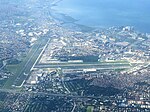XiamenAir Flight 8667

On 16 August 2018, a Boeing 737-800 operating as XiamenAir Flight 8667 skidded off the runway at Ninoy Aquino International Airport in Metro Manila while attempting to land in poor weather conditions. The crash occurred at 11:55 p.m. Philippine Standard Time (UTC+8) after a two-and-a-half-hour flight from Xiamen. The crash resulted in the destruction of the aircraft but no serious injuries among the crew or passengers. The damaged aircraft took 36 hours to remove from the runway, leading to a major disruption at the airport, which is the primary international gateway to the Philippines. The closure caused the cancellation of more than 200 domestic and international flights, affected more than 250,000 travelers, and prompted calls for enlargement of the airport or the construction of alternative airports to serve the country in the event of future disruptions. After the accident, the flight crew stated in interviews that a torrential downpour obstructed their view of the runway. The investigation revealed that despite the first officer of the aircraft calling for a go-around several times during the landing, the captain attempted to complete the landing despite not being able to clearly identify the runway. The investigation led to changes in airline policy relating to cockpit resource management, planning, and operations in poor weather conditions. It also led to runway improvements at the airport to remove runway obstructions that had caused most of the severe damage experienced by the aircraft.
Excerpt from the Wikipedia article XiamenAir Flight 8667 (License: CC BY-SA 3.0, Authors, Images).XiamenAir Flight 8667
C-5 South Link Expressway, Pasay Zone 20 (District 1)
Geographical coordinates (GPS) Address Nearby Places Show on map
Geographical coordinates (GPS)
| Latitude | Longitude |
|---|---|
| N 14.506583333333 ° | E 121.01641666667 ° |
Address
C-5 South Link Expressway
1705 Pasay, Zone 20 (District 1)
Philippines
Open on Google Maps








